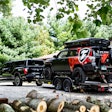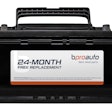 Kevin Motz explains the NEWAY LSZ Auxiliary Steerable Lift Axle Suspension System from SAF-Holland.
Kevin Motz explains the NEWAY LSZ Auxiliary Steerable Lift Axle Suspension System from SAF-Holland.SAF-Holland, which makes suspensions, fifth wheels, and landing gear, has introduced its Neway LSZ Auxiliary Steerable Lift Axle Suspension System.
“We’ve reinvented the 13.5k auxiliary lift axle system,” says Kevin Motz, marketing and sales manager, speaking to industry press at the Work Truck Show Wednesday in Indianapolis. “This new product is single-handedly changing the market.”
With a 17.5-inch package size, the LSZ’s revolutionary design is a minimum of 4 inches up to 10 inches shorter than comparable lift axles. This rugged, yet compact, design offers customers application versatility, enables easy installation and service, and provides extra frame rail space for component packaging and options, Motz explained.
The Super Chamber lift on the LSZ outperforms traditional air springs by providing a quick and reliable 4-second lift speed. This unique design is more durable than competitive lifts, and provides a stronger and more consistent lift force that keeps the axle securely stowed, according to the company. The Super Chamber position provides increased protection from road hazards and easier access for servicing.
The LSZ’s rolling lobe air springs are positioned at an angle, designed to deliver a superior spring rate for increased stability and ride quality. Its parallelogram design maintains precise steering geometry while reducing tire wear.
The design utilizes a kingpin assembly with spherical bearings, which eliminate thrust bearings that often require shimming and reaming. As a result, service requirements are greatly reduced.
The price will be “competitive” with similar equipment on the market, and will come with a variety of brake options, Motz added.
“This is a clean sheet design,” he says. “We didn’t use any existing components. How small can we make it? How light? This is what you end up when you start with clean sheet of paper.”










